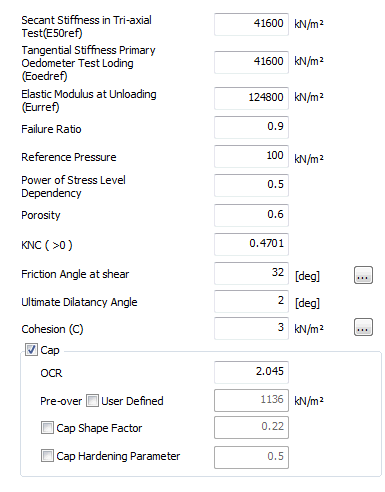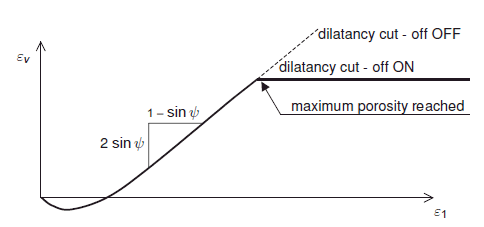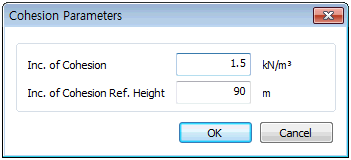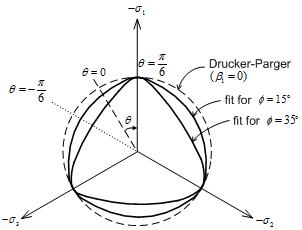This model is an improvement
on the Mohr-Coulomb model, generated by combining nonlinear
elastic models and elasto-plastic models to make a suitable
model for the behavioral characteristics of silt or sand
based ground. The Modified Mohr-Coulomb model can
simulate the Double stiffening behavior, which is not
affected by the shear failure or compressive yield.
The axial strain
and decrease in material stiffness caused by the initial
deviatory stress is similar to the Hyperbolic (nonlinear
elastic) model, but it is closer to the plastic theory
than elastic theory and has differences in dilatancy angle
consideration and yield cap application.
The main nonlinear
parameters are as follows.

[Elasticity modulus
: Three types of reference stiffness modulus]
This model is a
more detailed material model than the Mohr-Coulomb model
and the Elasticity modulus can be set at different values
for loading and unloading. In most cases, the Elasticity
modulus for unloading is set larger to prevent uplift
(bulging phenomenon) on the cutting surface due to stress
release during excavation modeling. For a rough approximation,
in case of hard soil (sand, OC clay), unloading stiffness
is set equal to 3 times of secant stiffness in standard
drained triaxial test. In case of soft soil, based on
the relationship between compression and swelling index,
unloading stiffness is approximately set equal to 10 times
of secant stiffness.

[Failure Ratio]
The ultimate deviatoric
stress is derived from the Mohr-Coulomb failure criterion.
As soon as the deviatoric stress reaches to the ultimate
value, the failure criterion is satisfied and perfectly
plastic yielding occurs. The ratio between the ultimate
and the quantity in deviatoric stress is given by the
failure ratio which must be smaller than1.
[Reference Pressure]
The reference stress
used in the triaxial test of specific strengths on the
nonlinear elastic curve. This can represent in-situ horizontal
stress at mid-level of soil layer depending on OCR(Over
Consolidation Ratio).
[Power Law nonlinear
elastic model coefficient]
Hardening soil model
is the stress dependency of soil stiffness. The reference
stiffness modulus which is used in this model has the
relationship with the confining stress dependent stiffness.
In this relation, the amount of stress dependency is given
by the power m. In case of soft clays, the power is recommended
to be taken equal to 1. The value of m around 0.5 for
hard soil like sand and OC clays can be used to simulate
a logarithmic compression behavior. In general, m is in
the range of 0.5 to 1.
[Porosity]
The void ratio is
the volume ratio between voids and soil particles. Here,
the porosity is the volume ratio between voids and the
total soil including water. Hence, unlike the void ratio,
the porosity cannot have a value larger than 1 and has
a value of 0.6 in general. When soil experience shearing,
dilating materials reach to the state of critical density.
In order to include this soil behavior by means of dilatancy
cut-off, the maximum porosity must be entered as advanced
parameters. When the soil is subject to shear hardening,
solver recalculates dilatancy angle.

[KNC]
KNC is the percentage
of K (Coefficient of earth pressure) in a normally consolidated
ground. In other words, it is the effective horizontal
stress ratio during maximum vertical stress. This can
be expressed as 1-sin
(Interior friction angle) and because general clays
have an interior friction angle of nearly zero, the value
is close to 1. However, it cannot be smaller than '0(zero)'
[Friction angle
at shear / Ultimate dilatancy angle / Cohesion]
Same as the friction
angle, dilatancy angle, cohesion parameters of the Mohr
coulomb material model.
 
Shear hardening
can be defined by equivalent plastic strain related to
the mobilized shear resistance automatically. Shear yield
surface can expand up to the Mohr-Coulomb failure surface.
Increment of Cohesion
with depth can be defined with additional options as in
Mohr-Coulomb model. The reference height must be inputted
based on the Global coordinates.

[Cap : Compression
Hardening]
Compressive yield
can happen when excessive compression forces occur on
the ground. Normally, the compressive forces that cause
yield are very large and the Mohr-Coulomb model has no
problems in simulating real soils with it omitted. However,
in order to simulate the compressive behavior more accurately,
the model considers circles or ellipses when considering
compressive failure, hence the name 'Cap'.
[OCR / Pc (Pre-
overburden pressure]
Yield surface of hardening soil model in p-q
plane has the length of preconsolidation stress and its
magnitude is determined by Cap shape factor and cap hardening
parameter. The smaller value of cap shape factor(α) lead
to steep caps underneath the Mohr-coulomb failure line.
For this, the preconsolidation stress can be calculated
from either the OCR(Over consolidation ratio) or the Pc(Pre-overburden
pressure).
The user can input the pressure at which compressive
failure occurs.
[Cap shape factor
/ Cap Hardening Parameter]
Use this variable
to change the shape of the Cap, a yield function shape.
Refer to Ch.4 of the Analysis manual for a more detailed
algorithm. These are considered automatically based on
the relation between KNC and Eoedref rather than directly
inputting parameters.

Following is the
summary of parameters for the hardening soil model.
Parameter |
Description |
Reference value
(kN, m) |
Soil stiffness and
failure |
E50ref |
Secant
stiffness in standard drained triaxial test |
Ei x (2 – Rf) /2
(Ei = Initial stiffness) |
Eoedref |
Tangent
stiffness for primary oedometer loading |
E50ref |
Eurref |
Unload
/ reloading stiffness |
3 x E50ref |
m |
Power
for stress-level dependency of stiffness |
0.5 ≤ m ≤ 1 (0.5
for hard soil,
1 for soft soil) |
C (Cinc) |
Effective
cohesion (Increment of cohesion) |
Failure parameter
as in MC model |
φ |
Effective friction
angle |
Failure parameter
as in MC model |
ψ |
Ultimate dilatancy
angle |
0 ≤ ψ
≤ φ |
Advanced parameters
(Recommend to use Reference value) |
Rf |
Failure Ratio (qf
/ qa) |
0.9 (< 1) |
Pref |
Reference pressure |
100 |
KNC |
Ko for normal consolidation |
1-sinφ
(< 1) |
Dilatancy cut-off |
Porosity |
Initial void ratio |
- |
Porosity(Max) |
Maximum void ratio |
Porosity < Porosity(Max) |
Cap yield surface |
OCR / Pc |
Over Consolidation
Ratio / Pre-overburden pressure |
When entering both
parameters,
Pc has the priority of usage |
α |
Cap Shape Factor
(scale factor of preconsolidation stress) |
from KNC (Auto) |
β |
Cap Hardening Parameter |
from Eoedref (Auto) |
|


